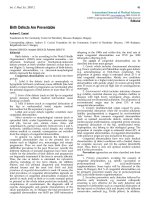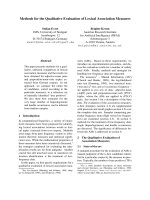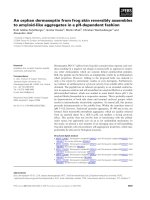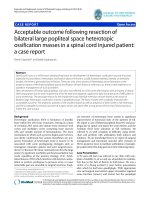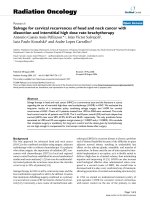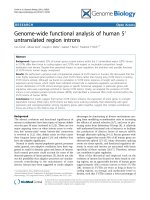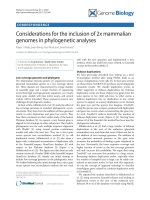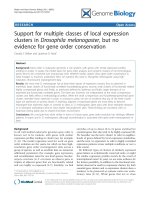Báo cáo y học: "Testing for the association of the KIAA1109/Tenr/IL2/IL21 gene region with rheumatoid arthritis in a European family-based study" ppt
Bạn đang xem bản rút gọn của tài liệu. Xem và tải ngay bản đầy đủ của tài liệu tại đây (250.78 KB, 7 trang )
BioMed Central
Page 1 of 7
(page number not for citation purposes)
Arthritis Research & Therapy
Open Access
Vol 11 No 2
Teixeira
et al.
Arthritis Research & Therapy
R
Research article
Testing for the association of the KIAA1109/Tenr/IL2/IL21 gene
region with rheumatoid arthritis in a European family-based study
Vitor Hugo Teixeira
1,2
, Celine Pierlot
1
, Paola Migliorini
3
, Alejandro Balsa
4
,
René Westhovens
5
, Pilar Barrera
6
, Helena Alves
7
, Carlos Vaz
7
,
Manuela Fernandes
7
, Dora Pascual-Salcedo
4
, Stefano Bombardieri
3
,
Jan Dequeker
5
, Timothy R Radstake
6
, Piet Van Riel
6
, Leo van de Putte
6
,
Antonio Lopes-Vaz
7
, Thomas Bardin
8
, Bernard Prum
9
,
François Cornélis
1,8,10,11
, Elisabeth Petit-Teixeira
1
for the European
Consortium on Rheumatoid Arthritis Families
1
GenHotel-EA3886, Evry University – Paris 7 University Medical School, AutoCure European Consortium member, 2 rue Gaston Crémieux, 91057
Evry-Genopole, France
2
Faculty of Medicine, University of Coimbra, Rua Larga, 3004-504 Coimbra, Portugal
3
Pisa University, Lungarno Pacinotti
43, 56126 Pisa, Italy
4
La Paz Hospital, Paseo Castellana 261, 28046 Madrid, Spain
5
KUL Leuven University, Naamsestraat 63, BE-3000 Leuven,
Belgium
6
Nijmegen University, Geert Grooteplein 10, 6500HB Nijmegen, The Netherlands
7
Porto San Joao Hospital, Estrada Interior da
Circunvalação, 4200 Porto, Portugal
8
Rheumatology Federation in Pôle Appareil Locomoteur, Lariboisière Hospital, Assistance Publique-Hôpitaux
de Paris, 2 rue Ambroise Paré, 75010 Paris, France
9
Laboratoire Statistique et Génome, Genopole, Tour Evry 2, 91000 Evry, France
10
Clinical
Genetics Unit in Pôle Laboratoire–Imagerie–Pharmacie Lariboisière Hospital, Assistance Publique-Hôpitaux de Paris, 2 rue Ambroise Paré, 75010
Paris, France
11
Adult Genetics Unit, Centre Hospitalier Sud Francilien, Evry-Corbeil, 59 bd H Dunant, 91106 Corbeil-Essonnes, France
Corresponding author: Elisabeth Petit-Teixeira,
R45
Received: 22 Jan 2009 Revisions requested:
17 Feb 2009
Revisions received:
6 Mar 2009
Accepted: 20 Mar 2009 Published: 20 Mar 2009
Arthritis Research & Therapy 2009, 11:R45 (doi:10.1186/ar2654)
This article is online at: />© 2009 Teixeira et al.; licensee BioMed Central Ltd.
This is an open access article distributed under the terms of the Creative Commons Attribution License ( />by/2.0), which permits unrestricted use, distribution, and reproduction in any medium, provided the original work is properly cited.
Abstract
Introduction A candidate gene approach, in a large case–control association study in the Dutch
population, has shown that a 480 kb block on chromosome 4q27 encompassing KIAA1109/Tenr/IL2/
IL21 genes is associated with rheumatoid arthritis. Compared with case–control association
studies, family-based studies have the added advantage of controlling potential differences in
population structure. Therefore, our aim was to test this association in populations of European
origin by using a family-based approach.
Methods A total of 1,302 West European white individuals from 434 trio families were genotyped
for the rs4505848, rs11732095, rs6822844, rs4492018 and rs1398553 polymorphisms using the
TaqMan Allelic discrimination assay (Applied Biosystems). The genetic association analyses for each
SNP and haplotype were performed using the Transmission Disequilibrium Test and the genotype
relative risk.
CI: confidence interval; IL: interleukin; OR: odds ratio; RA: rheumatoid arthritis; SNP: single nucleotide polymorphism.
Arthritis Research & Therapy 2009, 11:R45 />Page 2 of 7
(page number not for citation purposes)
Results We observed evidence for association of the heterozygous rs4505848-AG genotype with
rheumatoid arthritis (P = 0.04); however, no significance was found after Bonferroni correction. In
concordance with previous findings in the Dutch population, we observed a trend of
undertransmission for the rs6822844-T allele and rs6822844-GT genotype to rheumatoid arthritis
patients. We further investigated the five SNP haplotypes of the KIAA1109/Tenr/IL2/IL21 gene
region. We observed, as described in the Dutch population, a nonsignificant undertransmission of
the AATGG haplotype to rheumatoid arthritis patients.
Conclusions Using a family-based study, we have provided a trend for the association of the
KIAA1109/Tenr/IL2/IL21 gene region with rheumatoid arthritis in populations of European descent.
Nevertheless, we failed to replicate a significant association of this region in our rheumatoid
arthritis family sample. Further investigation of this region, including detection and testing of all
variants, is required to confirm rheumatoid arthritis association.
Introduction
Rheumatoid arthritis (RA) is a common autoimmune
inflammatory disease of unknown cause, in which both
genetic and environmental risk factors have been impli-
cated [1]. Since the genetic contribution to RA has been
estimated to be between 50% and 60%, identification of
genes contributing to disease is important for the under-
standing of underlying biological mechanisms [2].
In addition to human leucocyte antigen (HLA) [3] – the
first identified genetic risk factor – and four other repli-
cated regions – including the protein tyrosine phos-
phatase N22 gene (PTPN22) [4], the TNF receptor-
associated factor 1 gene (TRAF1)/complement compo-
nent factor 5 (C5) locus [5-7], the 6q23 locus near the
TNFα-induced protein 3 gene (TNFAIP3) [8,9], and the
signal transducer and activator of transcription 4 (STAT4)
gene [10,11] – a new genetic region associated with RA
was described in the Dutch population [12]. This region
encompassing KIAA1109/Tenr/IL2/IL21 is contained in a
large block (480 kb) of linkage disequilibrium located on
chromosome 4q27 and includes the IL2 and IL21 genes,
which are both plausible functional candidate loci for RA.
Five SNPs (rs4505848, rs11732095, rs6822844,
rs4492018 and rs1398553) of the block were investigated
in a sample set consisting of 1,047 RA patients and 929
controls, showing a significant association of the
rs6822844-T allele and the rs6822844-GT genotype (P =
0.0002, odds ratio (OR) = 0.72, 95% confidence interval
(CI) = 0.61 to 0.86; and P = 0.0009, OR = 0.71, 95% CI =
0.58 to 0.87, respectively) and of a specific haplotype
(AATGG) (P = 0.00025, OR = 0.70, 95% CI = 0.57 to 0.85)
with RA [12].
Furthermore, in the North American Rheumatoid Arthri-
tis Consortium and in the Epidemiological Investigation
of Rheumatoid Arthritis populations, rs6822844 and
rs1398553 SNPs were significantly associated with RA (P
= 0.01, OR = 0.84, 95% CI = 0.74 to 0.96; and P = 0.003,
OR = 1.17, 95% CI = 1.05 to 1.30, respectively) [6]. In
addition, the last meta-analysis performed with the North
American Rheumatoid Arthritis Consortium, the Epide-
miological Investigation of Rheumatoid Arthritis and the
Wellcome Trust Case Control Consortium studies, with
3,393 RA patients and 12,462 controls, observed evidence
of association of 4q27 with RA in an independent replica-
tion, suggesting that 4q27 is a true-positive association
[13].
Given that association studies compare the frequencies in
patients versus healthy individuals, unknown biases in
control frequencies may lead to spurious associations.
Family-based association studies therefore remain impor-
tant to definitively establish association, especially when
small effect sizes as well as variability in allele frequency
in different populations are observed. With the aim to fur-
ther substantiate the association at the KIAA1109/Tenr/
IL2/IL21 gene region, we therefore took advantage of one
of the largest reported European family resources dedi-
cated to RA family-based studies.
Materials and methods
Study design and study population
DNA was available from 434 white trio families from
Western Europe through the European Consortium on
Rheumatoid Arthritis Families collection followed by the
selection of individuals fulfilling the American College of
Rheumatology 1987 criteria for RA [14], according to the
rheumatologist in charge of the patient. Each family con-
sisted of one RA patient and both parents, with the ethnic-
ity as determined by grandparental origin.
Characteristics of the 434 RA European Caucasian fami-
lies are reported in Table 1. The 434 families included 308
families from France, 51 families from Italy, 32 families
from Spain, 20 families from Belgium, nine families from
the Netherlands and 14 families from Portugal. Families
with an additional affected sibling and with RA patients
Arthritis Research & Therapy 2009, 11:R45 />Page 3 of 7
(page number not for citation purposes)
aged <18 years were excluded. All individuals provided
written informed consent and the study was approved by
the Ethics Committee of Hôpital Kremlin-Bicêtre (Paris,
France).
Genotyping
All samples were genotyped using the TaqMan allelic dis-
crimination assay according to the manufacturer's instruc-
tions (Applied Biosystems, Foster City, CA, USA). Centre
d'Etude du Polymorphisme Humain DNA samples were
co-genotyped with all our samples, with no inconsisten-
cies detected. The genotyping success rate in the 434 trio
families was 100% (parents and probands included).
Statistical analysis
Using the previously reported frequencies for the
rs6822844-T allele in Dutch RA patients (14.1%) and in
controls (18.5%) [12], the power to detect an association
was calculated using the method described by Garnier and
colleagues [15]. The Hardy–Weinberg equilibrium was
checked in the control group (constituting the nontrans-
mitted parental chromosomes from the trio) prior to anal-
ysis. The association analysis relied on the Transmission
Disequilibrium Test, which for a given allele compares its
transmission from heterozygous parents to RA patients
with the transmission expected from Mendel's law (that
is, 50%) [16].
Secondly, we used the genotype relative risk, which com-
pares the affected offspring's genotype with the control
genotype derived from nontransmitted parental chromo-
somes [17]. ORs were calculated and 95% CIs were
approximated using Woolf's method [18], with Haldane's
correction [19]. Haplotypes were generated using GENE-
HUNTER software [20]. We then carried out multi-locus
tests of association testing haplotypes of SNPs using the
Transmission Disequilibrium Test and haplotype relative
risk. P values were adjusted with Bonferroni correction
[21] for each independent test performed.
Results
Power calculation
Using the previously reported frequencies for the
rs6822844-T allele in Dutch RA patients (14.1%) and in
controls (18.5%) [12], association analysis of 434 trio
families provides an 80% power to reach statistical signif-
icance (P <0.05).
Hardy–Weinberg equilibrium check
The five SNPs in the sample investigated were in Hardy–
Weinberg equilibrium in the control group.
Test for association in RA trio families
A total of 1,302 European individuals from 434 trio fam-
ilies (one RA case and both parents) were analyzed. Three
hundred and eight families were of French origin and 126
were from other continental Western European countries.
With the rs6822844 (G/T) SNP we observed deviation
from Mendel's first law, with a nonsignificant undertrans-
mission of 45.3% of the T allele to the patients in the 434
families (P = 0.24) (Table 2). No significant association
with RA was detected for the four other SNPs (Table 2).
Since RA is a heterogeneous disease and distinct subsets of
patients are characterized by the presence of autoantibod-
ies such a rheumatoid factor and anti-citrullinated protein
antibodies, we also performed a stratified analysis for the
presence or absence of rheumatoid factor or anti-citrulli-
nated protein antibodies; no associations were detected
(data not shown). Furthermore, the same tests were per-
formed in subgroups stratified for the presence of the
HLA-DRB1 shared epitope, PTPN22-1858T and TRAF1/C5
rs10818488-A variant, and no associations were detected
(data not shown). One of the advantages of family trio
data is that they provide perfectly matched controls for
each patient investigated. Each patient chromosome,
transmitted by a given parent, is perfectly matched for the
population of origin with the untransmitted chromosome
of each heterozygous parent. The genotype relative risk
Table 1
Characteristics of rheumatoid arthritis (RA) index cases
Characteristic RA families (n = 434)
Females (n (%)) 375 (86%)
Mean age at disease onset (years) (± standard deviation) 31.1 (9.7)
Mean disease duration (years) (± standard deviation) 9.8(8.5)
With bone erosions (n (%)) 336 (77%)
Seropositive for rheumatoid factor (n (%)) 323 (76%) (out of 425 RA patients)
Seropositive for anti-cycle citrullinated peptides antibodies (n (%)) 214 (76%) (out of 282 RA patients)
Carrying at least one HLA-DRB1 shared epitope allele (n (%))
a
152 (77%) (out of 197 RA patients)
Carrying at least one PTPN22-1858T allele (n (%)) 115 (27%)
Carrying the TRAF1/C5 rs10818488-A variant (n (%)) 277 (64%)
a
DRB1*0101, DRB1*0102, DRB1*0401, DRB1*0404, DRB1*0405, DRB1*0408, DRB1*1001.
Arthritis Research & Therapy 2009, 11:R45 />Page 4 of 7
(page number not for citation purposes)
analysis of the rs4505848 (A/G) SNP showed an associa-
tion of the heterozygous AG genotype with RA (P = 0.04,
OR = 1.32, 95% CI = 1.01 to 1.72) (Table 3). The signifi-
cance threshold was not reached, however, after Bonfer-
roni correction. In the four other SNPs, no association
with RA was detected (Table 3). In concordance with pre-
vious findings in the Dutch population, we observed an
undertransmission of the rs6822844-T allele and the
rs6822844-GT genotype, but without significance (Tables
2 and 3).
We further investigated the five SNP (rs4505848,
rs11732095, rs6822844, rs4492018 and rs1398553) hap-
lotypes of the KIAA1109/Tenr/IL2/IL21 gene region. These
seven haplotypes of the combined five SNPs of the block
have a pooled frequency of 96%. We observed a nonsig-
nificant undertransmission of the AATGG haplotype (P =
0.19) (Table 4), which was reported as associated with RA
in the Dutch study [12]. No relative risk was detected for
any haplotype genotype (data not shown). There were no
differences between families of French origin and other
continental Western Europe families, as well as no differ-
ences between paternal transmission and maternal trans-
mission for all statistical analyses performed (data not
shown).
Discussion
A recent case–control study in the Dutch population has
shown association of RA, celiac disease and type 1 diabe-
tes with the 4q27 gene region. In that study the
rs6822844-T allele was reported to be a perfect proxy for
a haplotype that is highly associated with autoimmune
diseases with frequencies of 0.13 in cases versus 0.19 in
North European controls [12].
In addition, a study from the Wellcome Trust Case Con-
trol Consortium identified this 4q27 region in a search for
risk factors for type 1 diabetes [22]. In a follow-up study,
some support for this association with type 1 diabetes was
provided [23]. The last meta-analysis of data from three
genome-wide association studies of type 1 diabetes – test-
ing 305,090 SNPs in 3,561 type 1 diabetes cases and 4,646
controls of European ancestry – obtained further support
for 4q27 type 1 diabetes association (P = 1.9 × 10
-8
), indi-
cating that this is a true type 1 diabetes locus [24]. The
same region was studied in inflammatory bowel diseases
such as Crohn's disease and ulcerative colitis. Four SNPs
Table 2
Family-based association of the chromosome 4q27 gene region with rheumatoid arthritis: Transmission Disequilibrium Test
4q27 region SNP Allele Transmitted allele Untransmitted allele Transmission
a
(%) P value
rs4505848 A 185 189 49.5 0.84
rs11732095 A 96 78 55.2 0.17
rs6822844 T 97 114 45.3 0.24
rs4492018 G 183 174 51.3 0.63
rs1398553 G 182 182 50 1
a
Percentage of transmission from heterozygous parents.
Table 3
Family-based association of the chromosome 4q27 gene region with rheumatoid arthritis: genotype relative risk
SNP Genotype RA cases (n) Controls (n) Odds ratio (95% confidence interval) P value
rs4505848 GG 38 51 0.72 (0.46 to 1.12) 0.18 (GG vs. AA + AG)
AG 213 183 1.32 (1.01 to 1.72) 0.04 (AG vs. GG + AA)
a
AA 182 199 0.85 (0.65 to 1.11) 0.28 (AA vs. AG + GG)
rs11732095 GG 7 9 0.77 (0.28 to 2.09) 0.8 (GG vs. AA + AG)
AG 87 101 0.83 (0.6 to 1.15) 0.28 (AG vs. GG + AA)
AA 340 324 1.23 (0.9 to 1.68) 0.23 (AA vs. AG + GG)
rs6822844 TT 8 11 0.72 (0.29 to 1.81) 0.64 (TT vs. GG + TG)
TG 99 110 0.87 (0.64 to 1.19) 0.43 (TG vs. TT + GG)
GG 327 313 1.18 (0.87 to 1.6) 0.32 (GG vs. TT + TG)
rs4492018 GG 235 232 1.03 (0.79 to 1.35) 0.89 (GG vs. AA + AG)
AG 174 171 1.03 (0.78 to 1.35) 0.89 (AG vs. GG + AA)
AA 25 31 0.79 (0.46 to 1.36) 0.49 (AA vs. AG + GG)
rs1398553 GG 204 214 0.91 (0.7 to 1.19) 0.54 (GG vs. AA + AG)
AG 195 175 1.2 (0.92 to 1.57) 0.20 (AG vs. GG + AA)
AA 35 45 0.77 (0.49 to 1.21) 0.30 (AA vs. AG + GG)
a
P value was not significant after Bonferroni correction.
Arthritis Research & Therapy 2009, 11:R45 />Page 5 of 7
(page number not for citation purposes)
were genotyped in three cohorts concerning 4,782 cases
(3,194 ulcerative colitis, 1,588 Crohn's disease) and 2,616
controls. All four SNPs were strongly associated with
ulcerative colitis and moderately associated with Crohn's
disease [25]. The 4q27 locus was also reported to be asso-
ciated with celiac disease [26]. Recent evidence is also pro-
vided of a role for this region in psoriasis and psoriatic
arthritis [27]. Finally, a genetic association with systemic
lupus erythematosus and two SNPs located within the IL-
21 gene was found in a case–control study (1,318 cases
and 1,318 controls) [28]. All of these studies provide evi-
dence that 4q27 seems to be a common locus for multiple
forms of autoimmune diseases.
In our family-based study, compared with the Dutch
study, we have detected a similar undertransmission of
the rs6822844-T allele, the rs6822844-GT genotype and
the AATGG haplotype, but without significance. Further-
more, we observed evidence of association between RA
and the rs4505848-AG genotype, but no significance was
found after Bonferroni correction. These results exclude
the 4q27 locus from being a major RA genetic region, but
a minor association should be not excluded and needs to
be tested in a larger RA trio sample. Furthermore the
already cited last RA meta-analysis, suggesting a 4q27
true-positive association, was performed in a large
number of individuals. For the rs4572894 SNP tested,
there was only a 2% variation between RA and non-RA
minor allele frequency (27% versus 29%, respectively)
with a P value of 1.1% [13]. The putative effect of the 4q27
locus in RA is therefore very small and difficult to replicate
in our RA family sample. In addition, a two-stage genome-
wide association study of RA in the Spanish population
did not found 4q27 as a RA susceptibility gene region
[29].
The long region of linkage disequilibrium at chromosome
4q27 contains several genes: testis nuclear RNA-binding
protein, a gene encoding a protein of unknown function
(KIAA1109), and genes encoding the IL-2 and IL-21
cytokines. Testis nuclear RNA-binding protein is
expressed primarily in the testis and KIAA1109 transcripts
are ubiquitous, hence their roles in autoimmunity are not
particularly compelling. Both IL-2 and IL-21 belong to the
type 1 cytokine family, share a large degree of homology,
and possess pleotropic functions in immune cells [26].
These two genes are both plausible functional candidates
as genetic modifiers of autoimmunity, and thus have par-
ticular interest to RA.
IL-2 exerts its effects on many cell types, the most promi-
nent of which is the T lymphocyte. Accordingly, a major
function of IL-2 is to promote proliferation and expansion
of both antigen-specific clones of CD4
+
and CD8
+
T cells
as well as to induce production of other cytokines. In
CD4
+
T cells, IL-2 plays a nonredundant role in the devel-
opment of CD4
+
CD25
+
regulatory T cells. Accumulating
evidence supports CD4
+
CD25
high
regulatory T cells play-
ing an essential role in controlling and preventing
autoimmunity [30]. In addition, the IL2 receptor (CD25)
susceptibility locus has recently been reported to be asso-
ciated with RA [22].
IL-21 is involved in both cell-mediated and humoral
responses and has a pleiotropic effect on a variety of
immune and nonimmune cells. In RA, the synovial fluid
and tissue have enhanced inflammatory responses to IL-
21 and elevated IL-21 receptor expression. In two animal
models – collagen-induced arthritis and adjuvant-
induced arthritis – treatment with an IL-21-blocking agent
ameliorated disease and/or reversed established disease,
and also lowered levels of IL-6 and IL-17 [31].
Conclusions
In the present study, using a family-based approach, we
have provided a trend for the association of the
KIAA1109/Tenr/IL2/IL21 gene region with RA in European
descent populations. Nevertheless, we failed to replicate a
significant association of this region in our RA family sam-
ple. Further investigation of this region, including detec-
tion and testing of all variants, is required to confirm RA
association.
Table 4
Family-based association for the seven haplotypes
a
: Transmission Disequilibrium Test
Haplotype Transmitted Untransmitted Transmission
b
(%) P value
GAGGA 113 112 50 0.95
AAGAG 133 126 52 0.69
AATGG 76 93 45 0.19
AAGGG 110 102 52 0.58
AGGGG 67 67 50 1
GAGGG 81 64 56 0.16
AAGGA 53 43 55 0.31
a
rs4505848 (G/A) – rs11732095 (G/A) – rs6822844 (T/G) – rs4492018 (G/A) – rs1398553 (G/A).
b
Percentage of transmission from heterozygous
parents.
Arthritis Research & Therapy 2009, 11:R45 />Page 6 of 7
(page number not for citation purposes)
Competing interests
The authors declare that they have no competing interests.
Authors' contributions
VHT carried out the molecular genetic studies. VHT and
EP-T carried out the design of the study and drafted the
manuscript. VHT, EP-T, BP and CP performed analysis of
the data. PM, AB, RW, PB, HA, CV, MF, DP-S, SB, JD, TRR,
PVR, LvdP, AL-V, TB and FC contributed to the recruit-
ment of families and to the acquisition of clinical data. All
authors read and approved the final manuscript.
Authors' information
The European Consortium on Rheumatoid Arthritis Fam-
ilies initiated with funding from the European Commis-
sion (BIOMED2) is coordinated by FC.
Acknowledgements
The present work was supported by Association Française des Polyarthri-
tiques, Société Française de Rhumatologie, Association Rhumatisme et Tra-
vail, European Union for AutoCure, Association Polyarctique, Groupe
Taitbout, Genopole
®
. VHT's work was supported by the Foundation for
Science and Technology, Portugal (grant SFRH/BD/23304/2005). The
authors are grateful to the RA patients, their family and rheumatologists for
their participation in this study. The authors thank Dr Sandra Lasbleiz and
Dr Pierre Fritz for reviewing clinical data.
References
1. Firestein GS: Evolving concepts of rheumatoid arthritis
[review]. Nature 2003, 423:356-361.
2. Helm-van Mil AH Van der, Wesoly JZ, Huizinga TW: Understand-
ing the genetic contribution to rheumatoid arthritis. Curr
Opin Rheumatol 2005, 17:299-304.
3. Huizinga TW, Amos CI, Helm-van Mil AH van der, Chen W, van
Gaalen FA, Jawaheer D, Schreuder GM, Wener M, Breedveld FC,
Ahmad N, Lum RF, de Vries RR, Gregersen PK, Toes RE, Criswell LA:
Refining the complex rheumatoid arthritis phenotype based
on specificity of the HLA–DRB1 shared epitope for antibod-
ies to citrullinated proteins. Arthritis Rheum 2005, 52:3433-3438.
4. Begovich AB, Carlton VE, Honigberg LA, Schrodi SJ, Chokkalingam
AP, Alexander HC, Ardlie KG, Huang Q, Smith AM, Spoerke JM,
Conn MT, Chang M, Chang SY, Saiki RK, Catanese JJ, Leong DU, Gar-
cia VE, McAllister LB, Jeffery DA, Lee AT, Batliwalla F, Remmers E,
Criswell LA, Seldin MF, Kastner DL, Amos CI, Sninsky JJ, Gregersen
PK: A missense single-nucleotide polymorphism in a gene
encoding a protein tyrosine phosphatase (PTPN22) is associ-
ated with rheumatoid arthritis. Am J Hum Genet 2004,
75:330-337.
5. Kurreeman FA, Padyukov L, Marques RB, Schrodi SJ, Seddighzadeh M,
Stoeken-Rijsbergen G, Helm-van Mil AH van der, Allaart CF, Verduyn
W, Houwing-Duistermaat J, Alfredsson L, Begovich AB, Klareskog L,
Huizinga TW, Toes RE: A candidate gene approach identifies
the TRAF1/C5 region as a risk factor for rheumatoid arthri-
tis. PLoS Med 2007, 4:e278.
6. Plenge RM, Seielstad M, Padyukov L, Lee AT, Remmers EF, Ding B,
Liew A, Khalili H, Chandrasekaran A, Davies LR, Li W, Tan AK, Bon-
nard C, Ong RT, Thalamuthu A, Pettersson S, Liu C, Tian C, Chen
WV, Carulli JP, Beckman EM, Altshuler D, Alfredsson L, Criswell LA,
Amos CI, Seldin MF, Kastner DL, Klareskog L, Gregersen PK:
TRAF1-C5 as a risk locus for rheumatoid arthritis: a genom-
ewide study. N Engl J Med 2007, 357:1199-1209.
7. Kurreeman FA, Rocha D, Houwing-Duistermaat J, Vrijmoet S, Teix-
eira VH, Migliorini P, Balsa A, Westhovens R, Barrera P, Alves H, Vaz
C, Fernandes M, Pascual-Salcedo D, Michou L, Bombardieri S, Rad-
stake T, van Riel P, Putte L van de, Lopes-Vaz A, Prum B, Bardin T,
Gut I, Cornelis F, Huizinga TW, Petit-Teixeira E, Toes RE: Replica-
tion of the tumor necrosis factor receptor-associated factor
1/complement component 5 region as a susceptibility locus
for rheumatoid arthritis in a European family-based study.
Arthritis Rheum 2008, 58:2670-2674.
8. Thomson W, Barton A, Ke X, Eyre S, Hinks A, Bowes J, Donn R, Sym-
mons D, Hider S, Bruce IN, Wellcome Trust Case Control Consor-
tium, Wilson AG, Marinou I, Morgan A, Emery P, YEAR Consortium,
Carter A, Steer S, Hocking L, Reid DM, Wordsworth P, Harrison P,
Strachan D, Worthington J: Rheumatoid arthritis association at
6q23.
Nat Genet 2007, 39:1431-1433.
9. Plenge RM, Cotsapas C, Davies L, Price AL, de Bakker PI, Maller J,
Pe'er I, Burtt NP, Blumenstiel B, DeFelice M, Parkin M, Barry R, Win-
slow W, Healy C, Graham RR, Neale BM, Izmailova E, Roubenoff R,
Parker AN, Glass R, Karlson EW, Maher N, Hafler DA, Lee DM, Sel-
din MF, Remmers EF, Lee AT, Padyukov L, Alfredsson L, Coblyn J, et
al.: Two independent alleles at 6q23 associated with risk of
rheumatoid arthritis. Nat Genet 2007, 39:1477-1482.
10. Lee HS, Remmers EF, Le JM, Kastner DL, Bae SC, Gregersen PK:
Association of STAT4 with rheumatoid arthritis in the
Korean population. Mol Med 2007, 13:455-460.
11. Remmers EF, Plenge RM, Lee AT, Graham RR, Hom G, Behrens TW,
de Bakker PI, Le JM, Lee HS, Batliwalla F, Li W, Masters SL, Booty MG,
Carulli JP, Padyukov L, Alfredsson L, Klareskog L, Chen WV, Amos
CI, Criswell LA, Seldin MF, Kastner DL, Gregersen PK: STAT4 and
the risk of rheumatoid arthritis and systemic lupus ery-
thematosus. N Engl J Med 2007, 357:977-986.
12. Zhernakova A, Alizadeh BZ, Bevova M, van Leeuwen MA, Coenen MJ,
Franke B, Franke L, Posthumus MD, van Heel DA, Steege G van der,
Radstake TR, Barrera P, Roep BO, Koeleman BP, Wijmenga C: Novel
association in chromosome 4q27 region with rheumatoid
arthritis and confirmation of type 1 diabetes point to a gen-
eral risk locus for autoimmune diseases. Am J Hum Genet 2007,
81:1284-1288.
13. Raychaudhuri S, Remmers EF, Lee AT, Hackett R, Guiducci C, Burtt
NP, Gianniny L, Korman BD, Padyukov L, Kurreeman FA, Chang M,
Catanese JJ, Ding B, Wong S, Helm-van Mil AH van der, Neale BM,
Coblyn J, Cui J, Tak PP, Wolbink GJ, Crusius JB, Horst-Bruinsma IE
van der, Criswell LA, Amos CI, Seldin MF, Kastner DL, Ardlie KG,
Alfredsson L, Costenbader KH, Altshuler D, et al.: Common vari-
ants at CD40 and other loci confer risk of rheumatoid arthri-
tis. Nat Genet 2008, 40:1216-1623.
14. Arnett FC, Edworthy SM, Bloch DA, McShane DJ, Fries JF, Cooper
NS, Healey L, Kaplan S, Liang M, Luthra H, Medsger T, Mitchel D,
Neustadt D, Pinals R, Schaller J, Sharp J, Wilder R, Hunder G: The
American Rheumatism Association 1987 revised criteria for
the classification of rheumatoid arthritis. Arthritis Rheum 1988,
31:315-324.
15. Garnier S, Dieudé P, Michou L, Barbet S, Tan A, Lasbleiz S, Bardin T,
Prum B, Cornélis F: IRF5 rs2004640-T allele, the new genetic
factor for systemic lupus erythematosus, is not associated
with rheumatoid arthritis. Ann Rheum Dis 2007, 66:828-831.
16. Spielman R, McGinnis E, Ewens W: Transmission test for linkage
disequilibrium: the insulin gene region and insulin-depend-
ent diabetes mellitus (IDDM). Am J Hum Genet 1993,
52:506-526.
17. Lathrop GM: Estimating genotype relative risks. Tissue Antigens
1983, 22:160-162.
18. Woolf B: On estimating the relation between blood group
and disease. Ann Hum Genet 1955, 19:251-253.
19. Haldane JB: The estimation and significance of the logarithm
of a ratio of frequencies. Ann Hum Genet 1956, 20:309-311.
20. Kruglyak L, Daly MJ, Reeve-Daly MP, Lander ES: Parametric and
nonparametric linkage analysis: a unified multipoint
approach. Am J Hum Genet 1996, 58:1347-1363.
21. Bonferroni CE: Teoria statistica delle classi e calcolo delle
probabilità. Pubblicazioni del R Istituto Superiore di Scienze Economiche
e Commerciali di Firenze 1936, 8:3-62.
22. Wellcome Trust Case Control Consortium: Genome-wide associ-
ation study of 14,000 cases of seven common diseases and
3,000 shared controls. Nature 2007, 447:661-678.
23. Todd JA, Walker NM, Cooper JD, Smyth DJ, Downes K, Plagnol V,
Bailey R, Nejentsev S, Field SF, Payne F, Lowe CE, Szeszko JS, Hafler
JP, Zeitels L, Yang JH, Vella A, Nutland S, Stevens HE, Schuilenburg H,
Coleman G, Maisuria M, Meadows W, Smink LJ, Healy B, Burren OS,
Lam AA, Ovington NR, Allen J, Adlem E, Leung HT, et al.: Robust
associations of four new chromosome regions from genome-
wide analyses of type 1 diabetes. Nat Genet 2007, 39:857-864.
Arthritis Research & Therapy 2009, 11:R45 />Page 7 of 7
(page number not for citation purposes)
24. Cooper JD, Smyth DJ, Smiles AM, Plagnol V, Walker NM, Allen JE,
Downes K, Barrett JC, Healy BC, Mychaleckyj JC, Warram JH, Todd
JA: Meta-analysis of genome-wide association study data
identifies additional type 1 diabetes risk loci. Nat Genet 2008,
40:1399-1401.
25. Festen EA, Goyette P, Scott R, Annese V, Zhernakova A, Brant SR,
Cho JH, Silverberg MS, Taylor KD, de Jong DJ, Stokkers PC, McGov-
ern D, Palmieri O, Achkar JP, Xavier RJ, Duerr RH, Daly MJ, Wij-
menga C, Weersma RK, Rioux JD: Genetic variants in the region
harbouring IL2/IL21 associated to ulcerative colitis. Gut 2009
in press.
26. van Heel DA, Franke L, Hunt KA, Gwilliam R, Zhernakova A, Inouye
M, Wapenaar MC, Barnardo MC, Bethel G, Holmes GK, Feighery C,
Jewell D, Kelleher D, Kumar P, Travis S, Walters JR, Sanders DS,
Howdle P, Swift J, Playford RJ, McLaren WM, Mearin ML, Mulder CJ,
McManus R, McGinnis R, Cardon LR, Deloukas P, Wijmenga C: A
genome-wide association study for celiac disease identifies
risk variants in the region harboring IL2 and IL21. Nat Genet
2007, 39:827-829.
27. Liu Y, Helms C, Liao W, Zaba LC, Duan S, Gardner J, Wise C, Miner
A, Malloy MJ, Pullinger CR, Kane JP, Saccone S, Worthington J, Bruce
I, Kwok PY, Menter A, Krueger J, Barton A, Saccone NL, Bowcock
AM: A genome-wide association study of psoriasis and psori-
atic arthritis identifies new disease loci. PLoS Genet 2008,
4:e1000041.
28. Sawalha AH, Kaufman KM, Kelly JA, Adler AJ, Aberle T, Kilpatrick J,
Wakeland EK, Li QZ, Wandstrat AE, Karp DR, James JA, Merrill JT,
Lipsky P, Harley JB: Genetic association of interleukin-21 poly-
morphisms with systemic lupus erythematosus. Ann Rheum
Dis 2008, 67:458-461.
29. Julià A, Ballina J, Cañete JD, Balsa A, Tornero-Molina J, Naranjo A,
Alperi-López M, Erra A, Pascual-Salcedo D, Barceló P, Camps J,
Marsal S: Genome-wide association study of rheumatoid
arthritis in the Spanish population: KLF12 as a risk locus for
rheumatoid arthritis susceptibility. Arthritis Rheum 2008,
58:2275-2286.
30. Chistiakov DA, Voronova NV, Chistiakov PA: The crucial role of
IL-2/IL-2RA-mediated immune regulation in the pathogene-
sis of type 1 diabetes, an evidence coming from genetic and
animal model studies [review]. Immunol Lett 2008, 118:1-5.
31. Spolski R, Leonard WJ: The Yin and Yang of interleukin-21 in
allergy, autoimmunity and cancer [review]. Curr Opin Immunol
2008, 20:295-301.
